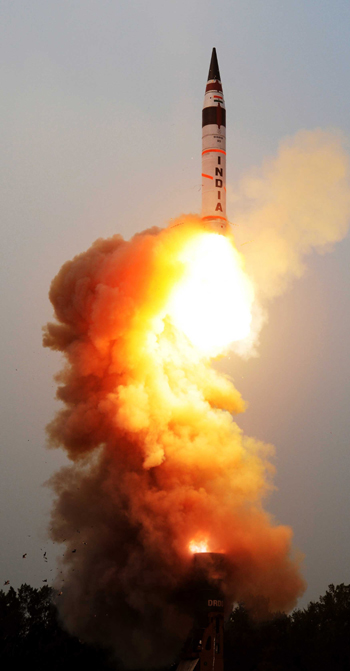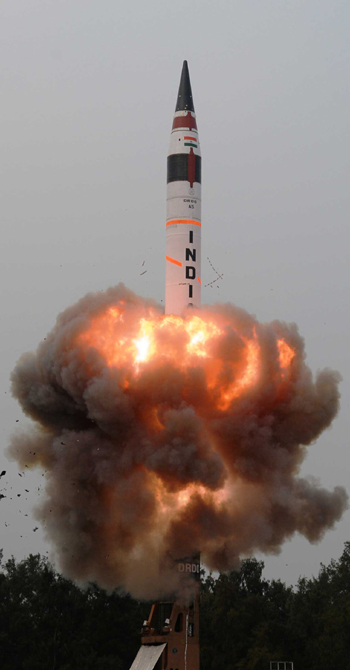| 
The 17-metre 5000 km-plus range missile was launched from a military test facility
in the Inner Wheeler Island launch site on India’s India’s east coast from a road
mobile vehicle and still and video shots of the missile zooming up were released
by DRDO to the media and public. DRDO, or Defence Research and Development Organisation,
has been in charge of India’s missile programme since 1983, and its Director General
Dr Avinash Chander, has been the driving force behind the long range missile programme. The
unarmed missile landed some 5500 km away at a predetermined place in southern
Indian Ocean. Its 20 minute flight was tracked throughout and Indian Navy ships
monitored the splashdown. All the radars and electro-optical systems along the
path monitored all the parameters of the Missile and displayed in real time. Incidentally,
Dr Chander was fired a couple of weeks back and as Jan 31 was his last day in
office, the test turned out to be his parting shot, or what his colleagues called
a proud sayonara to the organization he joined some 40 years ago as a young scientist
from one of India’s famed IITs. Prime Minister Narendra Modi congratulated
DRDO scientists while National Security Advisor Ajit Doval conveyed similar sentiments
to Dr Chander and his team. There have been two tests of Agni-5 earlier,
both successful, but this one from a mobile launcher and from its canister establishes
that the missile can easily be deployed in numbers anywhere in India for 360 degree
deterrence. The perceived threat though is from China, and some units are likely
to be positioned along the Indo-China border at various places. The range should
exceed 5500 km, and may go up to 7000 km. Dr Chander had told India
Strategic in an interview sometime back that there are no plans to
make missiles longer than this range. "What DRDO does is in line with the strategic
requirements of the country as mandated by the Government." A canister is
used to safely store and transport a missile, and then to fire it directly from
this cylindrical container by elevating it to the desired level.  All
long-range missiles made in India are propelled by solid fuels, but over the past
few years, there has been a tremendous improvement in their onboard systems and
components. In this particular test for instance, there was extensive use of indigenously-developed
composite materials. All
long-range missiles made in India are propelled by solid fuels, but over the past
few years, there has been a tremendous improvement in their onboard systems and
components. In this particular test for instance, there was extensive use of indigenously-developed
composite materials.
Notably, nuclear missiles are area weapons and need
no precision guidance. As for India, the main purpose is deterrence. The nuclear
tips, weighing some 1000kilos, have been ready and available for quite some time
and DRDO scientists have been working on challenges of delivery and range. Agni-5
should be operational by 2015-end after two more tests. The successful launch
was witnessed by Chief of Air Staff Air Chief Marshal Arup Raha and Commander
in Chief of the Strategic Forces Command Lt Gen Amit Sharma, who described the
success as “fantastic.” Significantly, as the senior-most Chief of Staff among
the three Service Chiefs and accordingly as Chairman Chiefs of Staff Committee,
the Air Chief plays a key role in coordinating India’s deployment of nuclear assets.
Procedurally, in case of a crisis, the NSA contacts the COSC to convey any decision/s
of the Government. The Chair rotates among the three Chiefs based on seniority.
So does the command of the Strategic Forces. According to DRDO, the
three-stage missile weighed 50 tonnes, was two metres in diameter and was built
largely with strong, heat-resistant composite materials. Initially, the
ICBM lifted out of the canister by its gas generators to about 20 meters – a standard
procedure – and then its first stage got ignited as planned, fast propelling it
into the sky. The flight continued on its predetermined path during which the
second, all composite light weight motor, followed by the third, innovatively
designed conical all composite rocket motor propelled the missile into space taking
it to a height of more than 600 km. DRDO spokesman Dr Ravi Gupta said the
missile, after reaching the peak of its trajectory, turned towards earth to continue
its journey towards the intended target with increasing speed caused by the earth’s
gravitational pull. Its flight path was precisely directed by the advanced onboard
computer and inertial navigation system. He pointed out that the earlier
two flights of Agni 5, fully successful, were in open configuration and had proved
the missile. “Today’s launch from a canister integrated with a mobile sophisticated
launcher, was in its deliverable configuration that enables launch of the missile
with a very short preparation time as compared to an open launch. It also has
advantages of higher reliability, longer shelf life, less maintenance and enhanced
mobility.” There was friction as the missile entered the earth’s atmosphere,
with atmospheric air rubbing the skin of the missile during the re-entry phase.
The temperature on the missile’s skin shot to beyond 4000 degree Celsius. But
the indigenously designed and developed carbon-carbon composite heat shield burnt
itself, literally sacrificially, and protected the payload. The well-designed
process helped maintain the inside temperature below 50 degree Celsius. Finally,
commanded by the onboard computer and use of a highly accurate ring laser gyro
based inertial navigation system, a most modern micro inertial navigation system
(MINS), fully digital control system and advanced compact avionics, the missile
hit the designated target point accurately, meeting all mission objectives. Addressing
the gathering and project team onsite, a happy and satisfied Dr Chander, said:
“This is a momentous occasion. It is India’s first ever ICBM launch from a canister
and is a giant leap in the country’s deterrence capability.” He termed
it a text book launch with the entire command network functioning in loop. Dr
Chander congratulated the entire DRDO community for the tremendous efforts put
in by them in making the country self reliant in long range missile systems. He
also observed: “I cherished every moment of my service in DRDO and I thank you
all for the relentless support given to me all through. I am leaving with a great
satisfaction of equipping the country with such advanced missiles. I wish the
entire DRDO community a great future.” Earlier, announcing the success
of the mission, Mission Director and DRDO’s Director General for Missiles and
Strategic Systems Dr VG Sekaran said, “All mission objectives have been achieved,
down range ships have confirmed final splashdown, the mission is a great success
and it is a momentous occasion.” A jubilant Dr Rajesh Kr Gupta, Project
Director Agni 5, described the success as “a historic achievement; a dream fulfilled.”
|